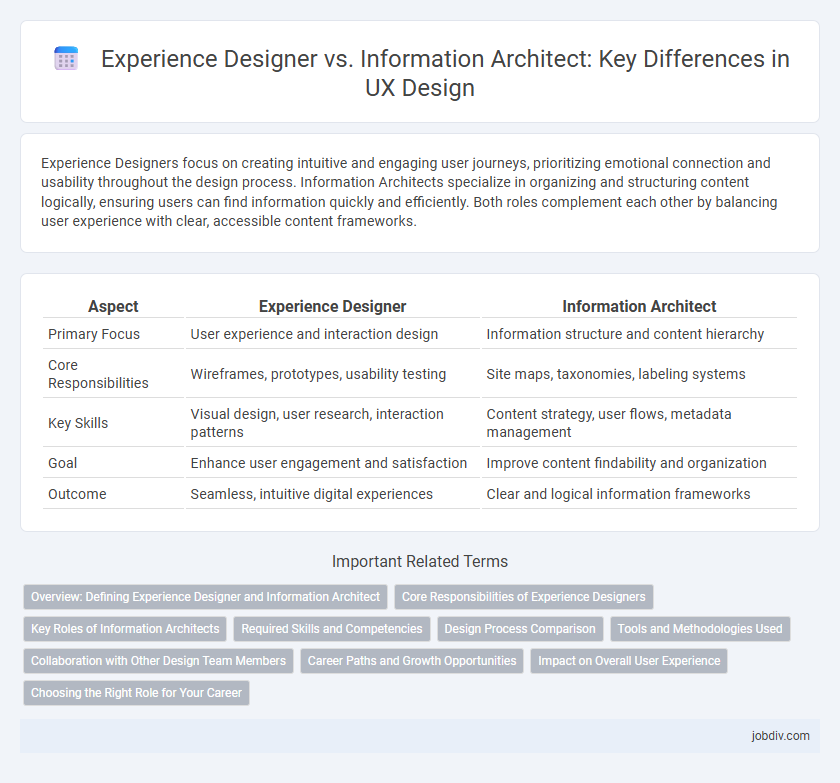Experience Designers focus on creating intuitive and engaging user journeys, prioritizing emotional connection and usability throughout the design process. Information Architects specialize in organizing and structuring content logically, ensuring users can find information quickly and efficiently. Both roles complement each other by balancing user experience with clear, accessible content frameworks.
Table of Comparison
| Aspect | Experience Designer | Information Architect |
|---|---|---|
| Primary Focus | User experience and interaction design | Information structure and content hierarchy |
| Core Responsibilities | Wireframes, prototypes, usability testing | Site maps, taxonomies, labeling systems |
| Key Skills | Visual design, user research, interaction patterns | Content strategy, user flows, metadata management |
| Goal | Enhance user engagement and satisfaction | Improve content findability and organization |
| Outcome | Seamless, intuitive digital experiences | Clear and logical information frameworks |
Overview: Defining Experience Designer and Information Architect
Experience Designers focus on crafting user interactions by blending visual design, usability, and emotional engagement to create seamless digital experiences. Information Architects organize and structure content, optimizing navigation and information flow to enhance findability and user comprehension within websites or applications. Both roles collaborate to ensure intuitive and effective user journeys but emphasize different aspects of the design process.
Core Responsibilities of Experience Designers
Experience Designers focus on crafting intuitive user journeys by analyzing user behavior, defining interaction flows, and ensuring seamless engagement across digital platforms. Their core responsibilities include wireframing, prototyping, and usability testing to optimize the overall user experience. Collaborating closely with stakeholders, they translate user needs into empathetic design solutions that enhance satisfaction and drive product success.
Key Roles of Information Architects
Information Architects specialize in organizing and structuring content to enhance user navigation and accessibility within digital products. They develop taxonomies, metadata frameworks, and navigation systems that enable intuitive interaction and efficient information retrieval. Their key role involves creating coherent information environments that align user needs with business goals, ensuring seamless communication and usability across platforms.
Required Skills and Competencies
Experience Designers require strong skills in user research, interaction design, and prototyping to create intuitive and engaging user journeys. Information Architects focus on competencies such as content strategy, taxonomy development, and wireframing to ensure effective organization and navigation of information. Both roles demand a deep understanding of user behavior, usability principles, and collaboration with cross-functional teams to deliver seamless digital experiences.
Design Process Comparison
Experience Designers focus on user interaction and emotional engagement throughout the design process, employing user research, prototyping, and usability testing to create intuitive interfaces. Information Architects concentrate on organizing content structure, defining taxonomies, and ensuring seamless navigation by applying card sorting and user flow mapping techniques. Both roles collaborate closely in iterative design cycles to balance user experience with logical information hierarchy.
Tools and Methodologies Used
Experience Designers utilize tools like Sketch, Figma, and Adobe XD to create interactive prototypes and user flows, employing methodologies such as user-centered design, usability testing, and wireframing to enhance overall user engagement. Information Architects rely on software like Axure RP, OmniGraffle, and Microsoft Visio to structure content hierarchies and develop site maps, applying methods including card sorting, taxonomy development, and content audits to optimize information organization and findability. Both roles collaborate closely but focus on distinct processes, with Experience Designers emphasizing user interactions and Information Architects concentrating on content structure.
Collaboration with Other Design Team Members
Experience Designers collaborate closely with UI designers, developers, and content strategists to create seamless user journeys that align with business goals. Information Architects work intimately with UX researchers and interaction designers to structure content and navigation systems, ensuring clarity and usability. Both roles depend on cross-functional teamwork to integrate user needs and technical constraints into cohesive design solutions.
Career Paths and Growth Opportunities
Experience Designers focus on enhancing user interactions and emotional engagement through iterative prototyping and user research, often advancing into roles like UX Director or Product Strategist. Information Architects specialize in structuring and organizing content for intuitive navigation, with career growth paths leading to Chief Information Officer or Content Strategy Lead roles. Both career tracks demand a deep understanding of user-centered design principles but emphasize different skill sets and strategic contributions within the design lifecycle.
Impact on Overall User Experience
Experience Designers shape user journeys by crafting intuitive interfaces and emotional connections, enhancing overall satisfaction and engagement. Information Architects structure content and navigation systems to ensure clarity, findability, and seamless information flow within digital products. Together, their collaboration drives a cohesive user experience by balancing aesthetic appeal with logical usability.
Choosing the Right Role for Your Career
Experience Designers prioritize user interaction and emotional engagement, creating seamless and intuitive digital journeys that enhance satisfaction and usability. Information Architects focus on structuring and organizing content logically, ensuring users can easily find and understand information within complex systems. Selecting the right role depends on whether you excel in crafting holistic user experiences or specializing in content hierarchy and navigation frameworks.
Experience Designer vs Information Architect Infographic

 jobdiv.com
jobdiv.com